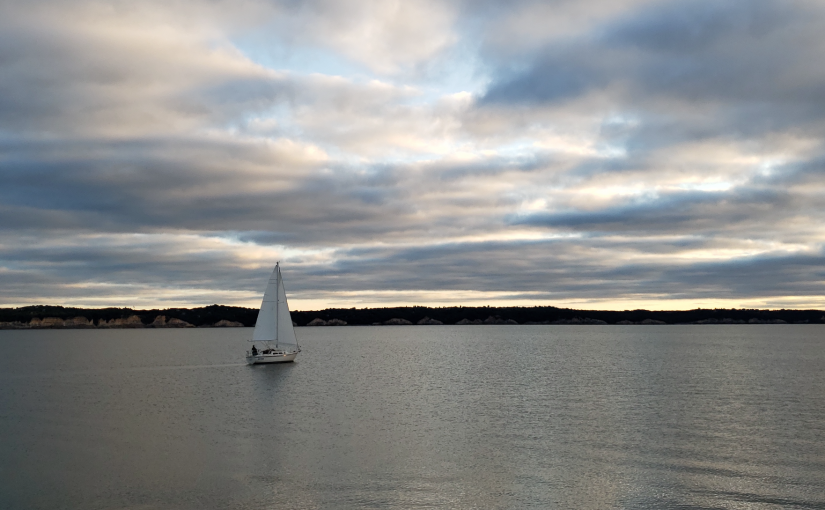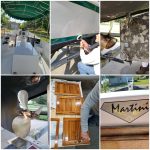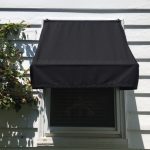At Sailrite®, the words sailing and sewing are often grouped together. Our Ultrafeed® Sewing Machine has a long-standing reputation of helping sailors sew and repair sails no matter where they are around the world. And Sailrite was the first American company to offer custom sail kits, providing even more flexibility to those who love the open water. Mike Raymond, a part-time sailor, has first-hand experience with everything that Sailrite is known for, and he was generous enough to tell us his story of sailing, sewing and self-reliance.
Q. How did you get started sailing? How long have you been doing it?
In 1980, I was living in Seldovia, Alaska, and had finished the previous year crab fishing. It was around this time that I decided my family and I would take a vacation to the Caribbean for six weeks. We chartered a Swan 48 sailboat with both a captain and a cook for a week. Following that week, we stayed for Antigua Sailing Week and then planned to return home. However, the captain wanted one more crew member for the return trip to Connecticut and asked me if I wanted to go. I agreed, so my wife and 10-year-old daughter flew home and I followed about two weeks later.
We then moved to Port Townsend, Washington, in early 1981. That’s where I crewed for several years on a C&C 39 in the Puget Sound races. I also made four more deliveries on the Swan 48 (my wife made three trips) between New England and the Caribbean. By 1986, I began building houses for a living and wasn’t able to take the time to sail very often.

Q. Can you tell me a little bit about your foray into sewing and the Ultrafeed?
In 2015, I bought an Express 27 to enter the 2016 R2AK race from Port Townsend to Ketchikan, Alaska (no motors allowed). My hope was to then complete a solo sail to Hawaii. My brother-in-law had recently bought a Sailrite Ultrafeed Sewing Machine and he decided to buy one for us. My wife was a sailmaker at Port Townsend Sails for six years in the late 1990s, so I could get advice from her. I decided to make three additional sails (all from Sailrite kits) for the boat prior to the race. This included a jib, asymmetrical spinnaker and a storm jib. I really enjoyed sewing the sails and it helped that I could use our community center for the expansive open space to work.

Q.Can you tell me about the time you sailed to Hawaii all by yourself? Where did you start and how long did it take you? How did the Sailrite Ultrafeed Sewing Machine play a part in your sailing journey?
I completed buying the additional electronics for the trip to Hawaii and departed in June from Port Townsend in early 2018. Unfortunately, I encountered several gales near the California/Oregon border that severely damaged two sails and compromised an additional one. That one further deteriorated and I was reduced to my second main and the storm jib. Additionally, the autopilot was damaged and there was no reasonable way to rig tiller steering with that sail combination, thereby having to heave-to whenever I had to sleep. That sail combination is also not very effective for heaving-to.
It basically took me six weeks to arrive at the North Shore of Oahu, which is at least twice as long as normal. None of the local sail lofts would fit me in to repair the damaged sails and it became obvious that I needed to bring the three damaged sails home to repair. I also needed to sew a new jib. Thankfully, I was able to order a Sailrite kit before leaving Hawaii, so it came in the mail shortly after I arrived home. [To clarify, Mike flew back home to Washington and left his boat in Hawaii, then flew back to Hawaii and sailed back to Washington.] The repairs and sewing the new jib took a few days and I was then able to return to Hawaii and prepare for the return trip. I had also purchased spare autopilot rams for the trip to be safe.

The return trip took longer than expected also (same six weeks) due to the outboard motor failing and so could not travel in no-wind situations. Also, there became a charging issue between the solar panels and the batteries that led to no power for several days to the electronics and autopilot. At that time I was about 1,000 miles from the U.S. coast, so that was a nervous time for sure.
I did have enough power to use my Iridium GO! to contact various sources to do a work-around with the charging, but the main batteries were somewhat compromised and provided erratic power to the autopilot. I was within less than 50 miles from the Washington coast when another gale caused damage to the sails and I needed to stop at a Canadian port to make some rigging repairs. I was then able to make the final return to Port Townsend, Washington. It was the most memorable sailing adventure I’ve had and would definitely do a few things differently if I ever considered repeating the experience.
Q. Do you still sail? And do you still plan on sewing with your Ultrafeed?
I’m not sure what other projects I’ll pursue with the Ultrafeed, but I definitely plan to keep it to do a broad range of projects. I’m currently remodeling our house and that’s taking all of my time for now. I’m open to helping friends deliver their boats to other ports or countries. I helped deliver a boat from San Diego to La Paz in Mexico last year. I’m 72 years old now, so I’m only considering interesting sailing trips.

Calm Seas Ahead
No matter what your next sailing adventure requires, Sailrite is there for you every step of the way. You can sew your own sails, sail covers, bimini, enclosure and more with our high-quality products and free tutorials. We’re proud to have been part of Mike’s journey, and we love hearing stories from everyday customers who make incredible projects with our help. Happy sailing and sewing!
Who We Are
Sailrite is your one-stop DIY shop! We are a passionate crew of do-it-yourselfers who strive to equip you with the supplies and how-to knowledge you need to tackle your next project. Do you want to learn upholstery, leatherwork, canvaswork, hobby sewing, bag making or more? We have the fabric, tools, hardware, sewing machines and notions you need to master any DIY. And even if you’ve never sewn before, our tutorials and how-to videos are designed for beginners and experienced crafters alike.
Start your DIY journey today: www.sailrite.com






















































